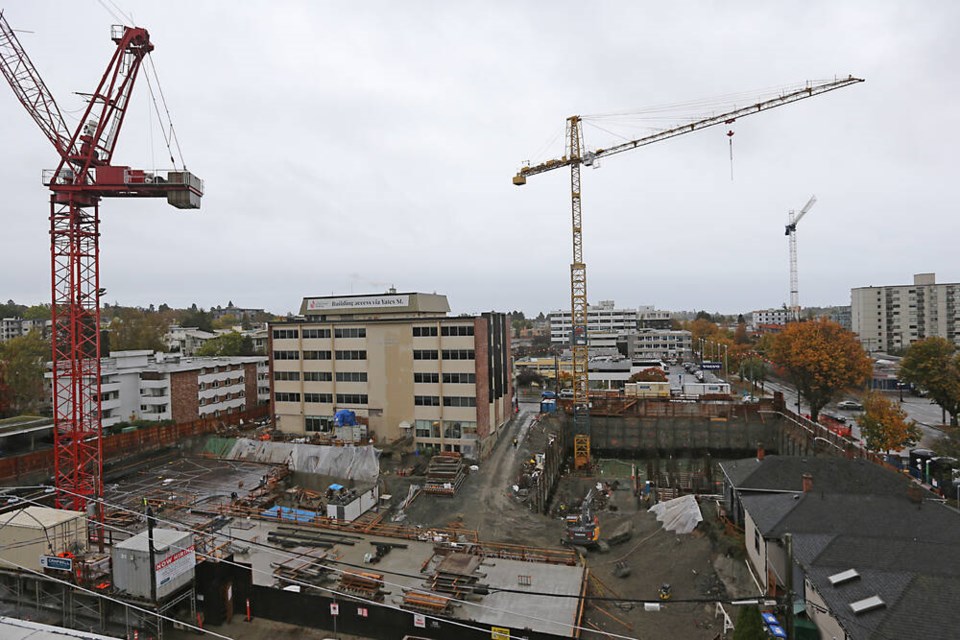With an unemployment rate of 3.5 per cent in November, Greater Victoria tied with Lethbridge, Alberta, for the lowest rate in western Canada.
As the capital region’s rate declines — it was at 4.3 per cent in October — it’s nearing the ultra-low rate of three per cent recorded in March 2019, when it was among the lowest in the country.
The labour force — those working and willing to work — in Greater Victoria rose to 226,300 in November from 225,600 the previous month.
Employment also increased to 218,300 last month from 216,000 in October, Statistics Canada said in its monthly labour force survey.
Some sectors in the region’s economy have grown substantially.
Construction projects underway throughout the region are fuelling jobs. Last month, there were 18,400 workers in the sector, up from 13,500 a year ago.
Health care and social assistance also showed strong growth, with 34,500 people working in the sector last month, up from 31,900 in November last year.
Accommodation and food services was another job-generator, coming in with 16,800 people employed in November, up from 13,700 for the same month in 2021.
Wholesale and retail trade climbed, room to 29,800 people employed from 27,100 in November of last year.
Declines were seen in the public sector with 24,700 working in the sector in November, down from 26,900 the previous year.
Nationally, Canada’s labour market remains tight with just 10,000 jobs added in November, TD said in its monthly analysis.
The city with the lowest unemployment rate was Sherbrooke, Que., at just 2.7 per cent, followed by Quebec City at three per cent and Peterborough, Ont., at 3.1 per cent.
In B.C., employment declined by 0.5 per cent to 2.74 million last month, pushing the unemployment level up slightly to 4.4 per cent from 4.2 per cent.
Despite the increase, the province’s rate is “still near record lows,” said B.C. Real Estate Association chief economist Brendan Ogmundson.
Canada’s unemployment rate is also still holding near historical lows, even as the Bank of Canada cranks up interest rates to slow the economy and stifle inflation.
Statistics Canada says Canada’s unemployment was 5.1 per cent last month, down from 5.2 per cent in October.
“The main overriding feature of today’s report was that you were continuing to gain jobs in Canada,” TD’s director of economics James Orlando said Friday.
“If you add up just the number of jobs gained [in] November and October, it’s pretty substantial.”
In October, the economy added a whopping 108,000 jobs, taking forecasters by surprise with the strong jobs gain.
Employment rose in several industries in November, including finance, insurance, real estate, rental and leasing, manufacturing and in information, culture and recreation, while it fell in construction as well as wholesale and retail trade.
Statistics Canada also noted in its report that the employment rate among women ages 25 to 54 hit 81.6 per cent in November, a record high in comparable data going back to 1976.
Canada’s labour market has remained remarkably strong despite signs of an economic slowdown. The unemployment rate fell to a record-low of 4.9 per cent in the summer and has edged up only slightly since then.
“The economy is clearly still doing very well. When you look at the labour market, you have not seen a slowdown,” Orlando said.
Centre for Future Work director Jim Stanford noted Canada’s unemployment rate is quite low by historical standards. At the same time, he said, it’s difficult to gauge where the labour market is headed.
“We had several months of very weak reports through the summer and early autumn, then we had a gangbusters report in October. And now we’re kind of back to a treading water kind of report,” he said.
Wages have continued to growth in October, though at a rate that lags inflation.
In November, wages were up 5.6 per cent compared to a year ago, marking the sixth consecutive month of above 5.0 per cent growth. In October, the annual inflation rate was 6.9 per cent.
Bank of Canada governor Tiff Macklem has characterized Canada’s low unemployment rate as unsustainable and said it’s contributing to high inflation.
“If you think the unemployment rate was already too low, then today’s number is bad news.” Stanford said.
The central bank is hoping to see the labour market ease in response to its aggressive interest rate hikes this year.
Recent research from the Bank of Canada suggests it believes it can bring inflation down without causing a large increase in unemployment.
Stanford is critical of the Bank of Canada’s assertion that a tight labour market is to blame for inflation given real wages have fallen.
“It’s, I think, mathematically impossible to say that wages are the source of inflation,” he said.
The central bank began raising interest rates in March, when it delivered the first of six consecutive rate hikes, and is expected to deliver another interest rate increase next week.
As the Bank of Canada nears the end of the rate hiking cycle, markets will be watching out for any indication next week on whether to expect another rate hike in January.
Orlando said job report Friday supports the forecast of a half-percentage point rate hike next week, with the door open to another rate hike in January.
“I don’t think by January you’re going to have enough data to convince you that the economy has turned enough,” he said.
“So you probably will likely see the policy rate getting into about 4.5 per cent [in] early 2023.”
cjwilson@timescolonist



